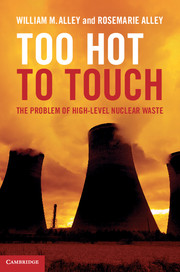Book contents
- Frontmatter
- Contents
- Acknowledgments
- List of units
- List of abbreviations
- Introduction
- Part I The problem
- Part II The mountain
- 12 The search for a geologic repository
- 13 Nevada wins the lottery
- 14 The Nevada Test Site
- 15 Yucca Mountain
- 16 How long is long?
- 17 Leaving almost no stone unturned
- 18 Surprise
- 19 Shake & bake
- 20 The project gets into hot water
- Part III No solution in sight
- Appendix Discussion questions
- References
- Index
20 - The project gets into hot water
from Part II - The mountain
Published online by Cambridge University Press: 05 February 2013
- Frontmatter
- Contents
- Acknowledgments
- List of units
- List of abbreviations
- Introduction
- Part I The problem
- Part II The mountain
- 12 The search for a geologic repository
- 13 Nevada wins the lottery
- 14 The Nevada Test Site
- 15 Yucca Mountain
- 16 How long is long?
- 17 Leaving almost no stone unturned
- 18 Surprise
- 19 Shake & bake
- 20 The project gets into hot water
- Part III No solution in sight
- Appendix Discussion questions
- References
- Index
Summary
The whole aim of practical politics is to keep the populace alarmed (and hence clamorous to be led to safety) by menacing it with an endless series of hobgoblins, all of them imaginary.
H. L. MenckenIn 2002, Jared L. Cohon, outgoing chairman of the Nuclear Waste Technical Review Board (NWTRB) and President of Carnegie-Mellon University, looked back at major accomplishments of the Board. Among these, he observed, “Proving something not to be true is the hardest thing to do in science, and a decidedly unglamorous undertaking. Yet, the Board did not shy away from the challenge presented by the hypothesis of geothermal upwelling. I think we did a very effective job in marshalling limited resources and helping to spawn reviews of what was a very complicated and controversial issue.”
The issue referred to by Jared Cohon – the question of hot water upwelling into the repository – was among the most complicated and controversial issues faced by the Yucca Mountain Project. While nearly every scientist even remotely associated with the project considered the possibility so unlikely it had been screened out of the TSPA, a few persistent individuals relentlessly stoked the issue to keep it alive. As it turned out, proving upwelling not to be true required scientific detective work beyond Sherlock Holmes’ wildest dreams.
unwelling water
Under today’s conditions, the proposed repository would sit about 1,000 feet (300 m) above the water table at Yucca Mountain. During past glacial epochs, the climate was much cooler and wetter with large freshwater lakes in the now arid Death Valley. Yet, evidence of previous water-level rises indicated that the repository would remain well above the water table even during a much wetter, cooler climate.
- Type
- Chapter
- Information
- Too Hot to TouchThe Problem of High-Level Nuclear Waste, pp. 297 - 306Publisher: Cambridge University PressPrint publication year: 2012



